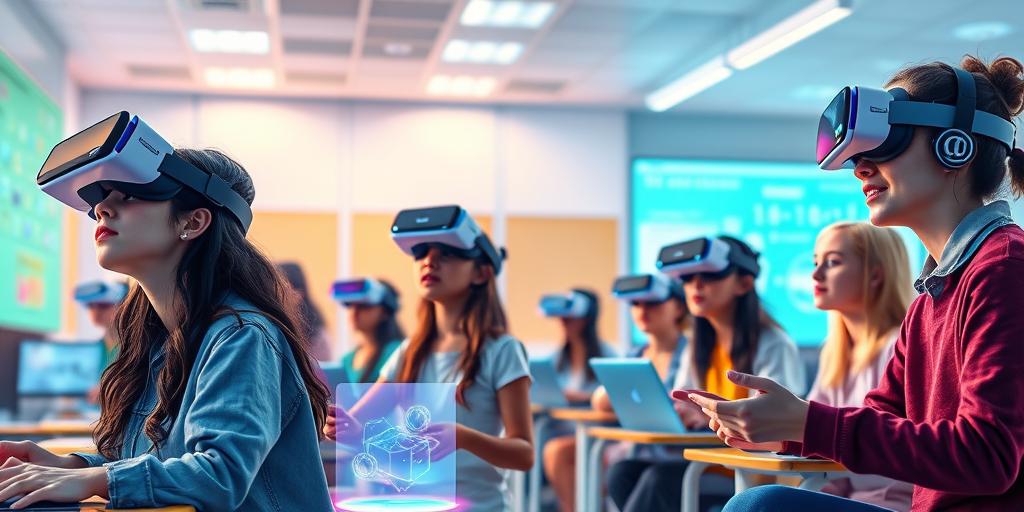Are you ready to witness the mind-blowing transformation of education? Emerging technologies are no longer a futuristic fantasy; they’re reshaping classrooms and learning experiences as we know it. From personalized learning pathways to virtual reality field trips, the possibilities are as vast as the digital landscape itself. Prepare to be amazed as we delve into how these technological advancements are revolutionizing the world of education, making learning more engaging, accessible, and effective than ever before.
Personalized Learning: The Future of Education?
Imagine a world where every student receives a unique learning experience, tailored to their individual needs, strengths, and pace. This isn’t science fiction; it’s the reality emerging technologies are creating. Artificial intelligence (AI) plays a pivotal role, providing adaptive learning platforms that adjust the difficulty and content in real-time, based on each student’s performance. These platforms can identify knowledge gaps and provide targeted support, ensuring no student is left behind. This means an end to the “one-size-fits-all” approach to education, creating a more equitable and effective learning environment.
AI-Powered Adaptive Learning Platforms
AI-powered platforms analyze student performance, identifying areas where they excel and where they struggle. This detailed understanding allows for the development of personalized learning plans, ensuring students receive the right support at the right time. No more lagging behind or getting bored—students receive a steady stream of perfectly tailored challenges and educational materials.
Personalized Feedback and Support
The personalized approach extends beyond content delivery. AI systems can offer tailored feedback, identifying misconceptions and suggesting strategies for improvement. This personalized support system helps students learn from their mistakes and develop a deeper understanding of the material. Automated assessment tools also play a role, providing instant feedback and freeing up teachers’ time for more direct student interaction.
Virtual and Augmented Reality: Immersing Students in Learning
Step into the world of immersive learning with virtual reality (VR) and augmented reality (AR). These cutting-edge technologies transform the classroom into a dynamic, interactive environment. Imagine students exploring ancient Rome, dissecting a virtual frog, or conducting experiments in a simulated lab—all without leaving the classroom. The possibilities are endless and revolutionizing how students engage with complex concepts.
Virtual Field Trips and Immersive Experiences
With VR, students can embark on exciting virtual field trips, exploring historical sites, natural wonders, or even the human body, all from the comfort of their classroom. These immersive experiences bring learning to life, engaging students in ways traditional methods simply can’t match.
Augmented Reality: Enhancing Real-World Learning
Augmented reality overlays digital information onto the real world. Imagine students using AR apps to interact with three-dimensional models of molecules, learn about the constellations by pointing their phones at the night sky, or even try on historical clothing and jewelry.
Big Data Analytics: Unveiling Insights into Learning
Big data analytics offers unprecedented insights into student learning patterns and behaviors. By analyzing vast amounts of data, educational institutions can identify trends, predict potential problems, and create more effective learning strategies. This data-driven approach enhances decision-making processes, allowing educators to personalize learning experiences and maximize student outcomes.
Data-Driven Decision Making
Using student data, educators can identify specific areas where students are struggling and adjust their teaching methods accordingly. They can create more targeted support programs, providing the necessary assistance where it is needed most. Early identification of students who might need extra help allows for timely intervention, improving educational outcomes.
Improving Educational Outcomes
The combination of data analysis and effective teaching methodologies leads to better educational outcomes. By identifying students at risk and providing personalized assistance, institutions can improve graduation rates, and reduce dropout rates, ultimately creating a more equitable educational system.
Gamification and Interactive Learning: Making Learning Fun
Let’s face it: Learning can sometimes feel like a chore. But what if learning could be fun and engaging? Gamification transforms educational content into interactive and rewarding experiences, captivating students and fostering a love of learning. Interactive simulations, educational games, and other engaging tools enhance student motivation and make complex concepts easier to grasp.
Interactive Simulations and Games
Interactive simulations allow students to experiment and explore concepts without fear of failure. They’re able to learn from mistakes in a safe and engaging environment. Educational games make learning enjoyable and rewarding, turning complex topics into captivating challenges.
Rewards and Progress Tracking
Gamification rewards students for their achievements, boosting motivation and providing a sense of accomplishment. Progress tracking features allow students to see their progress and maintain engagement. These fun and motivating methods can transform learning from a chore into an exciting adventure.
The future of education is bright, dynamic, and brimming with innovative technologies. Embracing these advancements isn’t just about keeping up with the times; it’s about creating a more engaging, accessible, and effective learning experience for every student. Don’t miss out on the revolution—jump in and transform your learning today!




